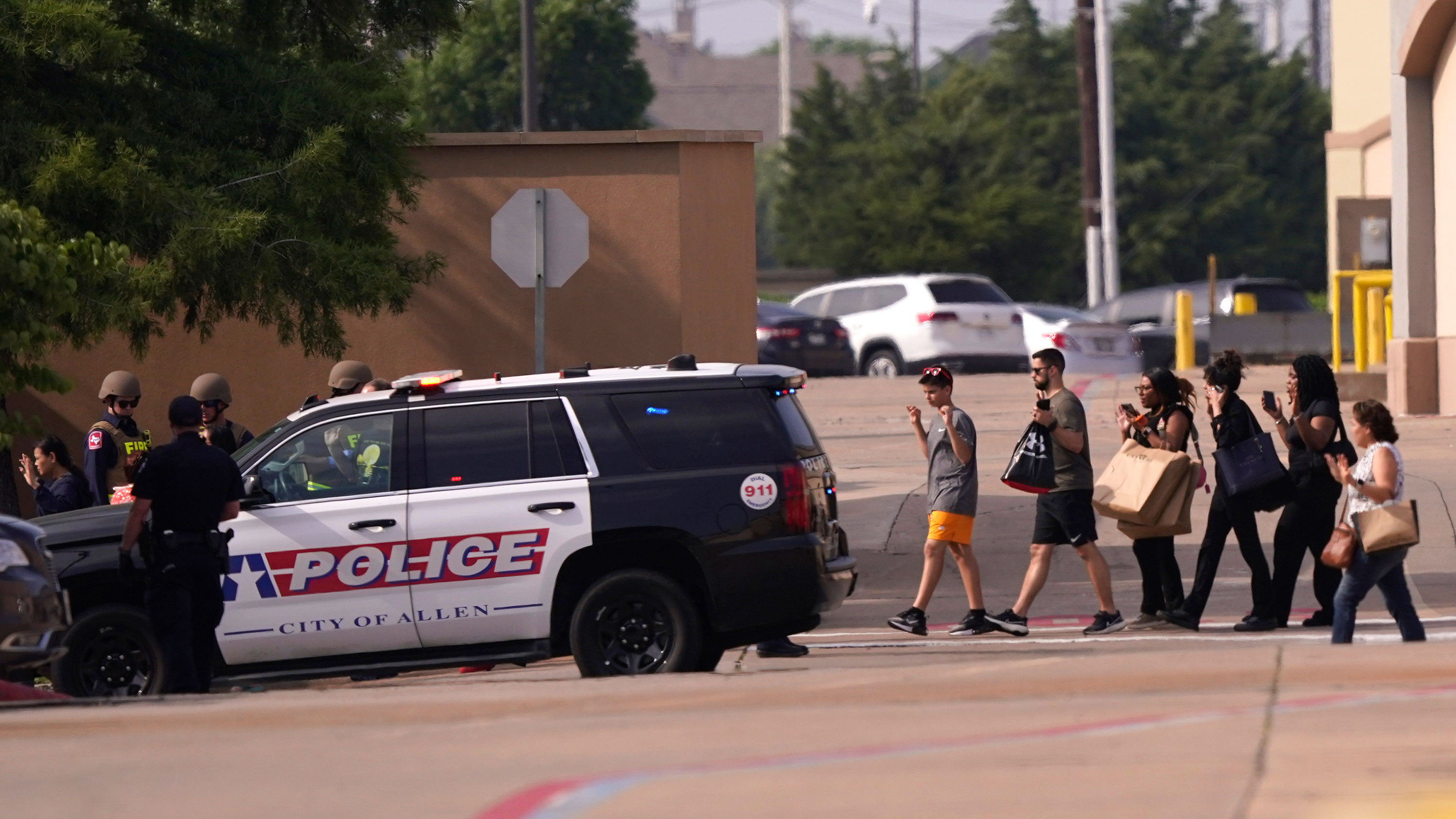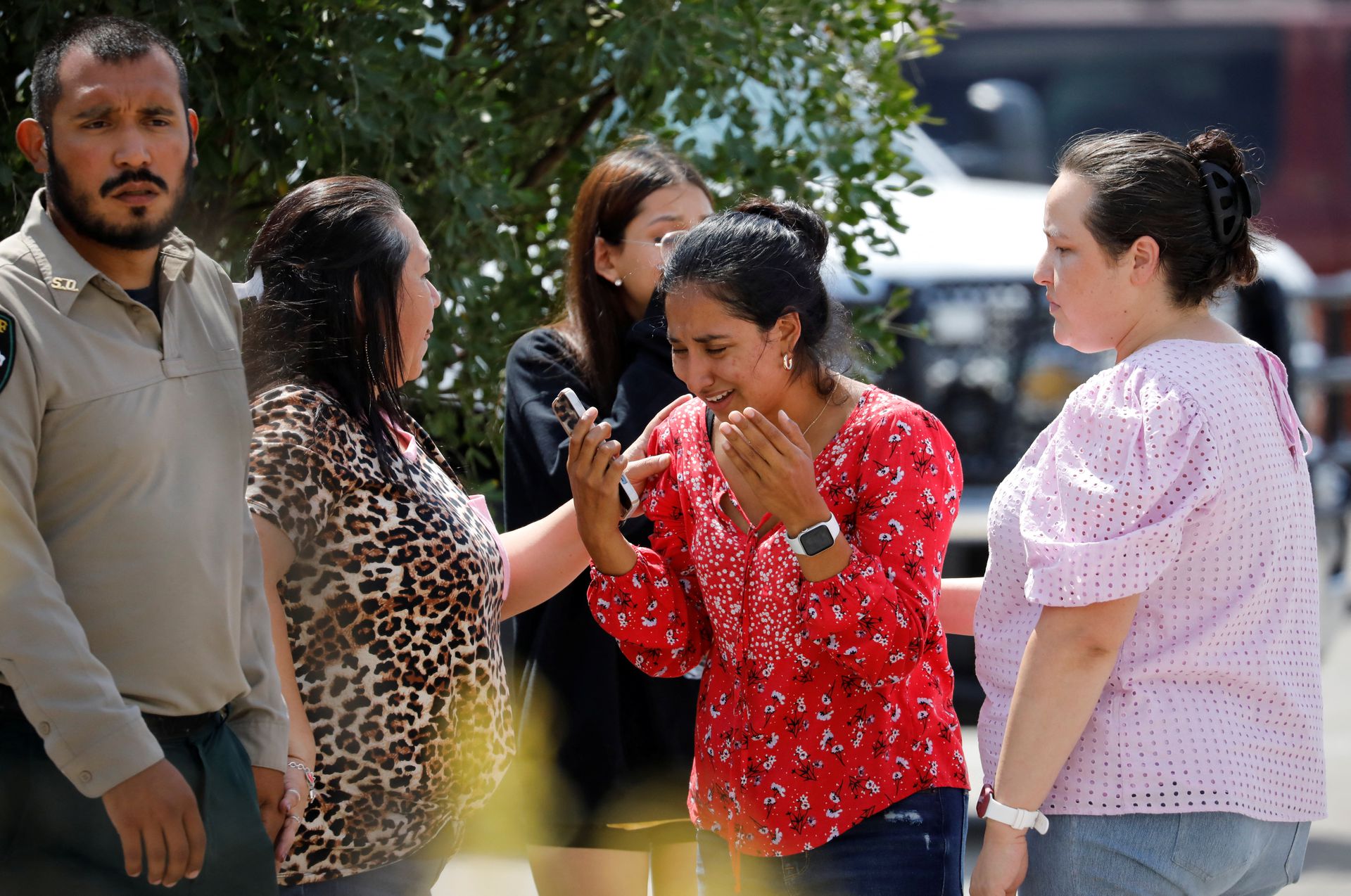
People raise their hands as they leave the shopping center after a shooting in Allen, Texas, May 6, 2023. /AP
People raise their hands as they leave the shopping center after a shooting in Allen, Texas, May 6, 2023. /AP
Gun violence continues to plague the U.S. as communities grapple with the devastating consequences of shootings across the nation.
One of the most tragic events recently happened in Allen, Texas, where a gunman bearing Nazi tattoos opened fire at a suburban Dallas shopping mall. Eight people lost their lives, including a three-year-old child.
Every year, 43,000 Americans die from gun violence, according to Giffords Law Center to Prevent Gun Violence, a U.S. public interest law center and nonprofit organization. Guns are also the leading cause of death among children under 18.
From schools and shopping malls to city streets and neighborhoods, no corner seems immune to the menace of gun-related incidents. Mass shootings, in particular, have captured headlines and left scars on the national psyche.
There have been 225 mass shootings as of 15 May 2023, data from the Gun Violence Archive shows.
Since 2018, the U.S. has experienced an average of over one mass shooting a day, and the number shows an upward trend, according to the Giffords Law Center.
Behind the increasing gun violence
The U.S. is the most heavily armed civilian population by far in the world. There are more guns than people in the country. According to an estimate by Small Arms Survey, a Geneva-based organization, there are about 393 million privately owned firearms in the U.S., which is higher than the country's population of about 330 million.
"The extensive ownership of firearms has been closely associated with the upsurge in gun violence," said Du Hua, an associate professor at the School of History at Wuhan University. He said the increase in gun violence can be attributed to the rise in firearm purchases driven by concerns for personal safety.
"Mass shootings instill fear in the general public, which is often intensified by paranoid conspiracy theories suggesting that the government intends to seize firearms."
As a result, people rush to purchase guns, leading to an increase in the availability of weapons and a higher risk of more mass shootings.
This pattern can be seen in Texas. Following the Uvalde shooting in May 2022 that killed 19 children and two teachers at Robb Elementary School, FBI background checks in Texas surged by 17 percent in the subsequent month of June.

A woman signs a cross at a makeshift memorial by the mall where several people were killed in a mass shooting in Allen, Texas, May 8, 2023. /AP
A woman signs a cross at a makeshift memorial by the mall where several people were killed in a mass shooting in Allen, Texas, May 8, 2023. /AP
In most developed countries, gun ownership has been traditionally centered on hunting. However, about two-thirds of U.S. gun owners cite protection as a major reason for owning a gun, as revealed by a 2017 survey by the Pew Research Center.
"When firearms are readily accessible, there is an increased potential for their misuse, whether it is intentional or accidental," said Du.
Nevertheless, several reasons stymie better gun control, which is the key to eliminating gun violence. One of them is the influence of gun interest groups in U.S. politics.
The National Rifle Association (NRA) remains the most powerful gun lobby in the country. Backed by a substantial budget, it wields significant influence in shaping gun policy.
Another reason is political polarization. With the two major political parties growing increasingly adversarial, the prospects of finding common ground on important political matters have become challenging. Also, the substantial power held by individual states further complicates forming a unified national gun control policy.
Amid the ongoing tragedy of frequent mass shootings, firearms continue to be deeply entrenched in American culture.
In the past, firearms were mostly sold to the military. This changed after the Civil War when "more people suddenly had experience with guns," and more guns were in circulation, according to Philip Gorski, a sociology professor at Yale University.
In the wake of wartime production, gun manufacturers faced a shortage of customers. So they started marketing guns as a means of self-defense, gradually evolving them into a symbol of masculinity.

A woman reacts outside the Ssgt Willie de Leon Civic Center, where students had been transported from Robb Elementary School after a shooting in Uvalde, Texas, May 24, 2022. /Reuters
A woman reacts outside the Ssgt Willie de Leon Civic Center, where students had been transported from Robb Elementary School after a shooting in Uvalde, Texas, May 24, 2022. /Reuters
The prevalence of guns in American culture can also be attributed to the rise of the conservative movement, which traces back to the mid–1930s.
"In recent years, modern American conservatism has evolved beyond a mere social trend of thought; rather, it has become a grassroots mobilization movement," said Du.
"Conservatives strongly uphold the principle of white supremacy and emphasize the revered status of guns among white individuals. They view them as symbols of individuality and freedom."
Many Americans hold their right to bear arms, enshrined in the Second Amendment to the U.S. Constitution, as sacred.
Even though the interpretations of this provision vary, it emerges as a significant institutional challenge in gun control, Du explained.
Does owning a gun guarantee safety?
Despite the persistent arguments from gun rights activists, backed by the NRA's longstanding narrative, that "a good guy with a gun" can stop gun violence, research has consistently shown otherwise.
One of the most famous research includes a 2015 study conducted by the Harvard Injury Control Research Center, which showed that individuals using guns for self-defense accounted for less than 1 percent of the 14,000 crimes analyzed from 2007 to 2011.
The study also found that having a firearm in the house does not necessarily provide effective protection during dangerous situations. On the contrary, it tends to amplify other risks. Individuals who confronted attackers with guns were more prone to getting injured compared to those who call the police or run away.
Another big concern is gun-related suicide. In a study published in 2020 in the New England Journal of Medicine, researchers tracked over 26 million adults living in California for 12 years, monitoring whether they buy handguns and if they died by suicide.
They found that those who purchased handguns were over three times more likely to die by suicide compared to those who hadn't bought guns. Similarly, women who had purchased handguns were more than seven times more likely to die by suicide.
"Easy access to firearms, especially handguns, is a significant risk factor for suicide," the research concluded.
As incidents of gun violence continue to rise in frequency, the issue of reconciling gun ownership and safety has drawn a new round of media coverage and sparked public discussion.
According to a recent CBS News poll, three in four Americans believe that mass shootings are preventable "if we really tried" rather than something they have to "accept as part of a free society." And around half of Americans say guns make their country "dangerous."
Meanwhile, 61 percent said the political debate over guns makes them feel frustrated, and 45 percent say they feel angry.
Paradoxically, addressing gun violence entails a gradual and challenging process, given that it stems from deeply rooted cultural factors within the country.